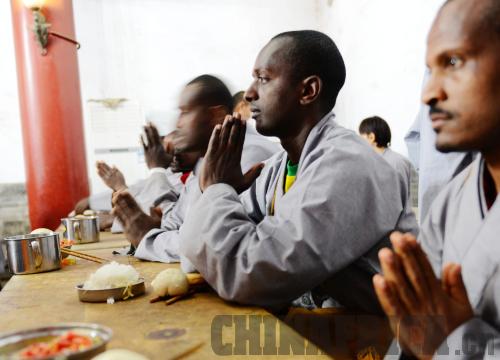When a gray day dawned upon the sleeping Dengfeng City in Henan Province, a group of people were already well awake. After a short walk along the stone path, they gathered at an old temple. They pressed palms together and bowed to the master, a Chinese monk in a yellow robe, who returned the courtesy in the same way.
A day's exercise began.
In the early morning mists the picturesque scene was like something out of a Chinese kungfu movie, except for the fact that all of the students are Africans.
The 20 students, from Tanzania, Ethiopia, Mauritius, Uganda and Nigeria, came to central China in September 2013. In the following three months, they were trained in the Shaolin Temple, the origin of Shaolin Kungfu.
"With all this my life will never remain the same," Ogwang Mark, a Ugandan, said about his Shaolin experience.
Work hard
The program Shaolin Kungfu Training Class for African Disciples was launched by the Chinese Ministry of Culture as part of the government's plan to further promote cultural exchanges between China and Africa. The 20 "disciples" were selected from among the most outstanding martial arts practitioners in African countries, but the life in the Shaolin Temple was still an enormous challenge for each of them.
"I cried a lot in the first couple of days," said Peace Emezue, a 32-year-old Nigerian woman. In Nigeria, Emezue works as a fitness coach, and as a karate champion, she was selected for the program by the Nigerian Government in a bid to encourage women in Nigeria to take up martial arts.
Emezue was amused by the simple and peaceful life in the Shaolin Temple, but the tough training and early morning exercises were beyond imagining. She had to get up at 5:30 a.m. and kept learning and practicing until 9 p.m.; the routine went on six days a week for three months.
The word "kungfu" literally means "work hard," and people who work hard are described as having a lot of "kungfu." According to Abbot Shi Yongxin, the training program is short for serious kungfu study, but the first three months is a stage full of hardship for any practitioner.
And the differences in weather and food posed more difficulties for African students who came from afar. Wamala Peter from Uganda said that many students came down with colds when the winter arrived in November. "Even though [we became sick], our confidence and wills were always strong, because the energetic and responsible instructors and masters have been helping us."
The training program also included a Chinese language course to help the Africans better understand the master's teaching. For most of the students, who came to China for the first time, learning Chinese language was even more difficult than the kungfu training.
"I never thought of an opportunity to learn the Chinese language. It's really hard, but I will continue to learn it through the Internet when I'm back home," said Peter Zanang Kazah, a Nigerian karate practitioner.
When the program came to an end, most of the students were becoming well-adapted to life in Shaolin, which turned out to be quite rewarding. Some of them lost some weight but gained a stronger constitution. During the graduation ceremony on December 18, the African students gave a kungfu performance to show what they had learned in the three months at the temple that included classic fist routines and fighting techniques with swords and sticks as weapons.

Vegetarian food and strict prayer rituals form part of Shaolin training
Shaolin disciples
Dawit Terefe is an Ethiopian kungfu actor who has practiced martial arts for over two decades. Before coming to Shaolin, Terefe expected the program to focus on higher-level techniques like faster moves or more accurate strikes. He was right, but that's only half of it. Another important lesson the African students learned at Shaolin was how best to utilize rest.
Every Wednesday afternoon, there was a one-hour meditation class. Students sat in abstraction for 40 minutes, learning how to attain spiritual peace.
Meditation is an important element of Chan (Zen) Buddhism. Although the foundation for modern kungfu began in 527 when Indian monk Ta Mo arrived at the Shaolin Temple and created the 18 Buddhist Fists, the Shaolin Temple is also the place where the Chan doctrines were first preached in China in 495.
"After coming to Shaolin, I realized that it's more than just fighting techniques but was a profound religious background," said Peter Zanang Kazah. "Now I'm ready to learn the real meaning of the kungfu and its culture."
"Some people asked me how many people are learning Shaolin Kungfu around the world," said Abbot Shi Yongxin. "I would say millions, or even more than that."
Since a German became its first foreign disciple in 1989, the Shaolin Temple has been promoting its martial arts and culture abroad by setting up overseas training centers. But every year hundreds of people still come from all around the world to the temple in Henan Province, to spend several months for a unique experience, or years to achieve an advanced level.
Here all the students, Chinese and foreigners, are required to act like a real Shaolin disciple. They dress in grey robes and have vegetarian meals complete with rituals before eating. Also, they join the monks' morning classes every Monday.
Abbot Shi Yongxin believes that Shaolin Kungfu not only strengthens people's body, but also spreads a lifestyle that allows followers to obtain inner peace. He told his African disciples to take Shaolin Temple as their "second and spiritual home."
"Shaolin Temple is a good place where I met people with different religions and cultural backgrounds," said Emezue. "I'm sure that I will become a new person when I'm back home. The things I learned in Shaolin are priceless."